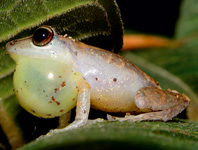Abstract
Isotrias penedana Trematerra, 2013 was described from north Portugal based on males alone. Unidentified females were associated with the males using DNA barcoding, revealing sexual dimorphism in the species. Males and females differ in forewing shape, markings, and size, with females significantly smaller than males. The female is described and illustrated for the first time. We also document the species’ occurrence in northern Spain.
References
Akaike, H. (1973) Information theory and an extension of the maximum likelihood principle, In: Petrov, B.N. & Csaki, B.F. (Eds.), Second International Symposium on Information Theory. Academiai Kiado, Budapest, pp. 267–281.
Darriba, D., Taboada, G.L., Doallo, R. & Posada, D. (2012) jModelTest 2: more models, new heuristics and parallel computing. Nature Methods, 9 (8), 772–772.
http://dx.doi.org/10.1038/nmeth.2109Guindon, S., Dufayard, J.F., Lefort, V., Anisimova, M., Hordijk, W. & Gascuel, O. (2010) New algorithms and methods to estimate maximum-likelihood phylogenies: assessing the performance of PhyML 3.0. Systematic Biology, 59, 307–307.
http://dx.doi.org/10.1093/sysbio/syq010Hajibabaei, M., Janzen, D.H., Burns, J.M., Hallwachs, W. & Hebert, P.D.N. (2006) DNA barcodes distinguish species of tropical Lepidoptera. Proceedings of the National Academy of Sciences of the United States of America, 103, 968–971.
http://dx.doi.org/10.1073/pnas.0510466103Hebert, P.D.N., Penton, E.H., Burns, J.M., Janzen, D.H. & Hallwachs, W. (2004) Ten species in one: DNA barcoding reveals cryptic species in the neotropical skipper butterfly Astraptes fulgerator. Proceedings of the National Academy of Sciences of the United States of America, 101, 14812–14817.
http://dx.doi.org/10.1073/pnas.0406166101Razowski, J. (1984) Palaearctic Polyorthini (Lepidoptera, Tortricidae). Acta Zoologica Cracoviensia, 27, 287–298.
Razowski, J. (1987) The genera of Tortricidae (Lepidoptera). Part I: Palaearctic Chlidanotinae and Tortricinae. Acta Zoologica Cracoviensia, 30, 141–355.
Razowski, J. (2002) Tortricidae of Europe. 1. Tortricinae and Chlidanotinae. František Slamka, Bratislava. 247 pp.
Tamura, K., Peterson, D., Peterson, N., Stecher, G., Nei, M. & Kumar, S. (2011) MEGA5: Molecular Evolutionary Genetics Analysis using Maximum Likelihood, Evolutionary Distance, and Maximum Parsimony Methods. Molecular Biology and Evolution, 28 (10), 2731–2739.
http://dx.doi.org/10.1093/molbev/msr121Trematerra, P. (1991) Nuovi dati geonemici e descrizione della femmina di Isotrias joannisana (Turati, 1921) (Lepidoptera Tortricidae). Fragmenta Entomologia, 23 (1), 53–58.
Trematerra, P. (2013) Isotrias penedana sp. n., a new species of Lepidoptera (Tortricidae: Chlidanotinae: Polyorthini) from Portugal. Journal of Entomological and Acarological Research, 45 ( e1), 1–3.
http://dx.doi.org/10.4081/jear.2013.e1

